第四章凸凹模型面成形磨削工艺
- 格式:ppt
- 大小:15.76 MB
- 文档页数:88
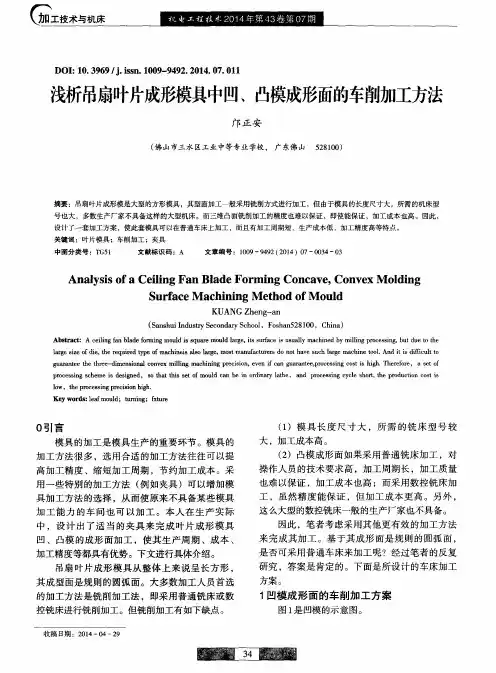
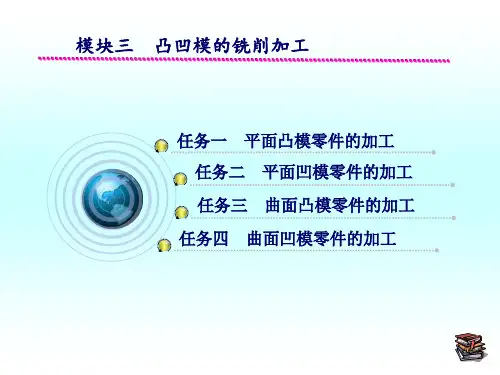
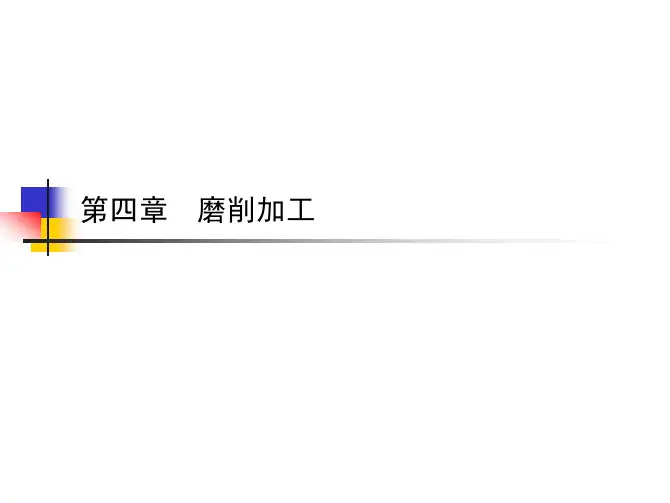
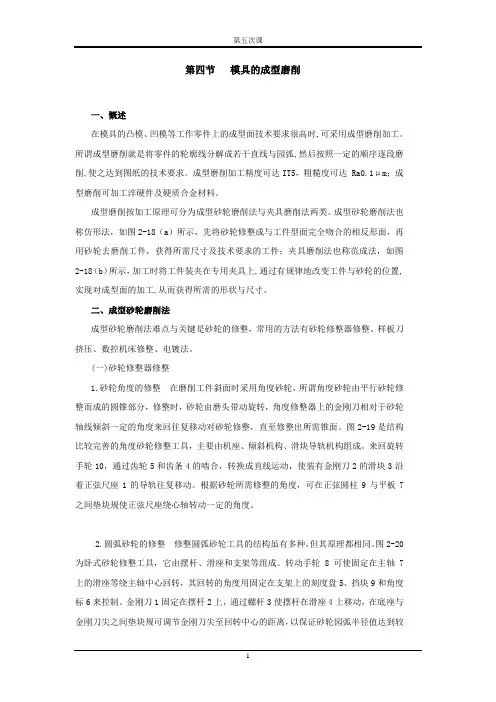
第四节模具的成型磨削一、慨述在模具的凸模、凹模等工作零件上的成型面技术要求很高时,可采用成型磨削加工。
所谓成型磨削就是将零件的轮廓线分解成若干直线与园弧,然后按照一定的顺序逐段磨削,使之达到图纸的技术要求。
成型磨削加工精度可达IT5,粗糙度可达 Ra0.1μm;成型磨削可加工淬硬件及硬质合金材料。
成型磨削按加工原理可分为成型砂轮磨削法与夹具磨削法两类。
成型砂轮磨削法也称仿形法,如图2-18(a)所示,先将砂轮修整成与工件型面完全吻合的相反形面,再用砂轮去磨削工件,获得所需尺寸及技术要求的工件;夹具磨削法也称范成法,如图2-18(b)所示,加工时将工件装夹在专用夹具上,通过有规律地改变工件与砂轮的位置,实现对成型面的加工,从而获得所需的形状与尺寸。
二、成型砂轮磨削法成型砂轮磨削法难点与关键是砂轮的修整,常用的方法有砂轮修整器修整、样板刀挤压、数控机床修整、电镀法。
(一)砂轮修整器修整1.砂轮角度的修整在磨削工件斜面时采用角度砂轮,所谓角度砂轮由平行砂轮修整而成的圆锥部分,修整时,砂轮由磨头带动旋转,角度修整器上的金刚刀相对于砂轮轴线倾斜一定的角度来回往复移动对砂轮修整,直至修整出所需锥面。
图2-19是结构比较完善的角度砂轮修整工具,主要由机座、倾斜机构、滑块导轨机构组成。
来回旋转手轮10,通过齿轮5和齿条4的啮合,转换成直线运动,使装有金刚刀2的滑块3沿着正弦尺座1的导轨往复移动。
根据砂轮所需修整的角度,可在正弦圆柱9与平板7之间垫块规使正弦尺座绕心轴转动一定的角度。
2.圆弧砂轮的修整修整圆弧砂轮工具的结构虽有多种,但其原理都相同。
图2-20为卧式砂轮修整工具,它由摆杆、滑座和支架等组成。
转动手轮8可使固定在主轴7上的滑座等绕主轴中心回转,其回转的角度用固定在支架上的刻度盘5、挡块9和角度标6来控制。
金刚刀1固定在摆杆2上,通过螺杆3使摆杆在滑座4上移动,在底座与金刚刀尖之间垫块规可调节金刚刀尖至回转中心的距离,以保证砂轮园弧半径值达到较高的精度,如图2-21所示。
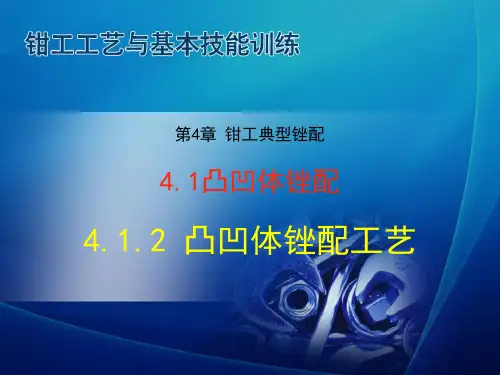
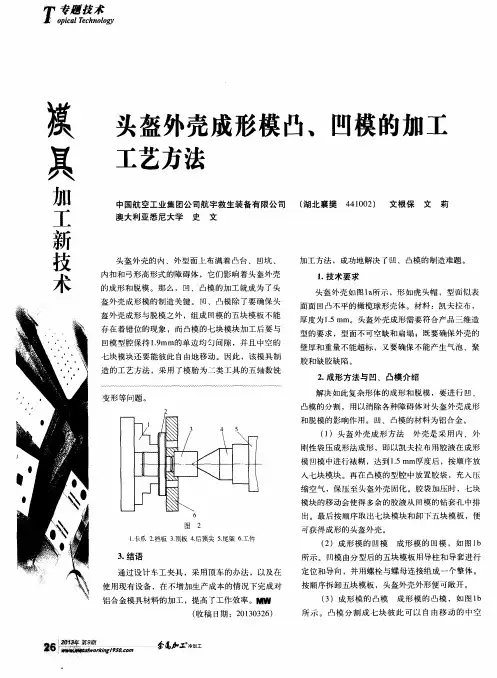
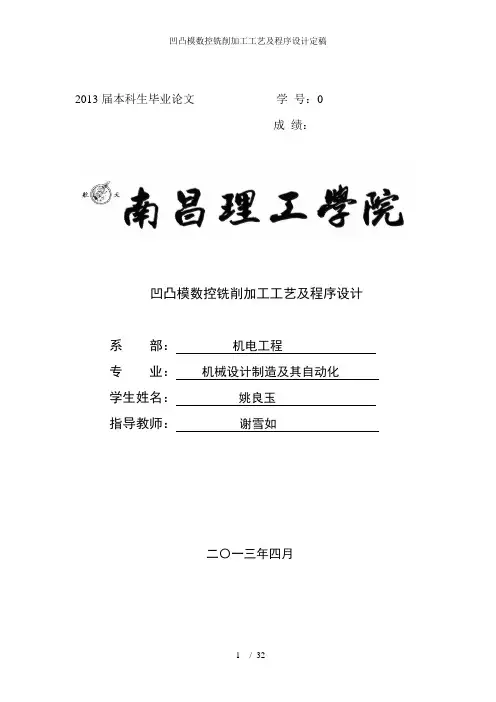
2013届本科生毕业论文学号:0成绩:凹凸模数控铣削加工工艺及程序设计系部:机电工程专业:机械设计制造及其自动化学生姓名:姚良玉指导教师:谢雪如二〇一三年四月毕业论文诚信声明本人郑重声明:所呈交的毕业论文《凹凸模数控铣削加工工艺及程序设计》是本人在指导老师的指导下,独立研究、写作的成果。
论文中所引用是他人的无论以何种方式发布的文字、研究成果,均在论文中以明确方式标明。
本声明的法律结果由本人独自承担。
毕业论文作者签名:姚良玉 2013年4月20日摘要数控机床的出现以及带来的巨大利益,引起世界各国科技界和工业界的普遍重视。
发展数控机床是当前我国机械制造业技术改造的必由之路,是未来工厂自动化的基础。
数控机床的大量使用,需要大批熟练掌握现代数控技术的人员。
数控技术的应用不但给传统制造业带来了革命性的变化,使制造业成为工业化的象征,而且随着数控技术的不断发展和应用领域的扩大,它对国计民生的一些重要行业的发展起着越来越重要的作用。
随着科技的发展,数控技术也在不断的发展更新,现在数控技术也称计算机数控技术,加工软件的更新快,CAD/CAM的应用是一项实践性很强的技术。
如像UG , PRO/E , Cimitron , MasterCAM ,CAXA制造工程师等。
数控技术是技术性极强的工作,尤其在模具领域应用最为广泛,所以这要求从业人员具有很高的机械加工工艺知识,数控编程知识和数控操作技能。
本文主要通过铣削加工薄壁配合件的数控工艺分析与加工,综合所学的专业基础知识,全面考虑可能影响在铣削、钻削、铰削加工中的因素,设计其加工工艺和编辑程序,完成配合要求。
【关键词】铣削钻削铰削 CAD/CAM 薄壁板类配合件零件加工The advent of NC machine tool which bring huge benefits, technology and industry around the world.Seriously,the development of numerical control machine tool is the necessary way of current in our country mechanical manufacturing industry technical innovation, is the factory in the future;The basis of automation, Use of CNC machine tools, need a large number of skilled personnel of modern numerical control technology. The application of numerical control technology not only brings revolutionary change to traditional manufacturing industry, manufacturing industry has become a symbol of industrialization, and with the continuous development of numerical control technology and application field expands, it to the national economy and people's livelihood some important industry plays a more and more important role in the development.Along with the development of science and technology, numerical control technology is also in constantly development update, now the numerical control also called computeriged numerical control technology, processing software updates fastly, the application of CAD/CAM is a practical technology. Cimitron such as UG, PRO/E, MasterCAM, CAXA manufacturing engineers, etc.Numerical control technology is a highly technical work, especially in the field of mould is most widely used, so this requires the employees have high mechanical processing knowledge, knowledge of CNC programming and CNC operation skills. This paper mainly through the milling machining with a CNC technology analysis and processing, comprehensive basic knowledge of my major in, comprehensive consider may affect in the milling, drilling, cutting and processing factors, design the process and editing program, complete with requirements.【Keywords】stranded milling drilling cutting CAD/CAMThin plate assemblies parts processing第1章零件加工工艺的分析 (1)1.1 零件的技术要求分析 (1)1.2 零件的结构工艺分析 (1)1.3 编程尺寸的确定 (4)1.4 毛坯的选择 (5)1.5 工艺过程设计 (5)1.5.1 定位基准确定 (6)1.5.2 零件加工方案确定 (6)1.5.3 零件加工走到路线确定 (6)1.6 选择机床、工艺装备等 (8)1.6.1 数控机床及系统选择 (8)1.6.2 夹具及装夹方案确定 (8)1.6.3 刀具选择方案 (9)1.6.4 量具选择方案 (11)1.7 确定切削用量 (11)第2章凹凸模数控加工 (13)2.1 数控工艺文件 (13)2.1.1 凹模的加工工艺文件 (13)2.1.2 凸模的加工工艺文件 (17)2.2 数控加工程序设计 (21)小结 (25)参考文献 (26)致谢 (27)第1章零件加工工艺的分析1.1零件的技术要求分析零件的尺寸公差在0.05—0.1mm之间,且凸模薄壁厚度为8mm,区域面积较大,表面粗糙度也比较高,达到了Ra1.6um,相对难加工,加工时容易产生变形,处理不好可能会导致其壁厚公差及表面粗糙度难以达到要求。
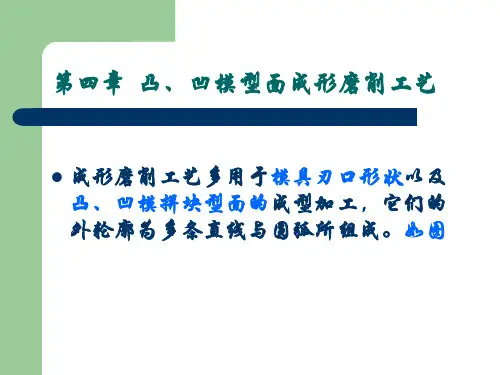
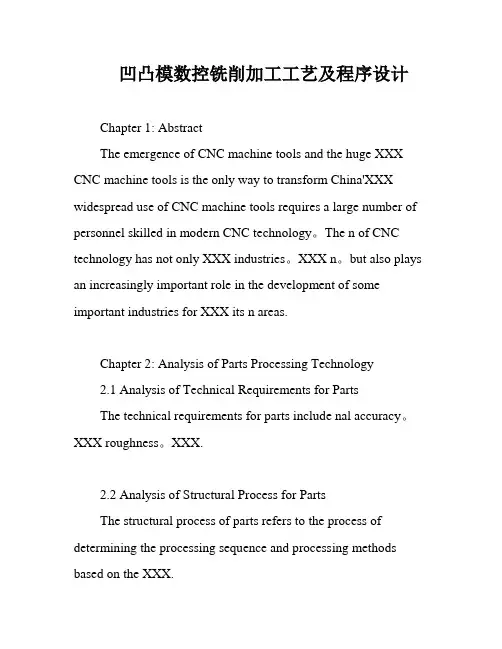
凹凸模数控铣削加工工艺及程序设计Chapter 1: AbstractThe emergence of CNC machine tools and the huge XXX CNC machine tools is the only way to transform China'XXX widespread use of CNC machine tools requires a large number of personnel skilled in modern CNC technology。
The n of CNC technology has not only XXX industries。
XXX n。
but also plays an increasingly important role in the development of some important industries for XXX its n areas.Chapter 2: Analysis of Parts Processing Technology2.1 Analysis of Technical Requirements for PartsThe technical requirements for parts include nal accuracy。
XXX roughness。
XXX.2.2 Analysis of Structural Process for PartsThe structural process of parts refers to the process of determining the processing sequence and processing methods based on the XXX.2.3 n of Programming nsThe programming ns are determined based on the technical requirements for parts and the structural process of parts.2.4 XXX BlanksXXX such as material。
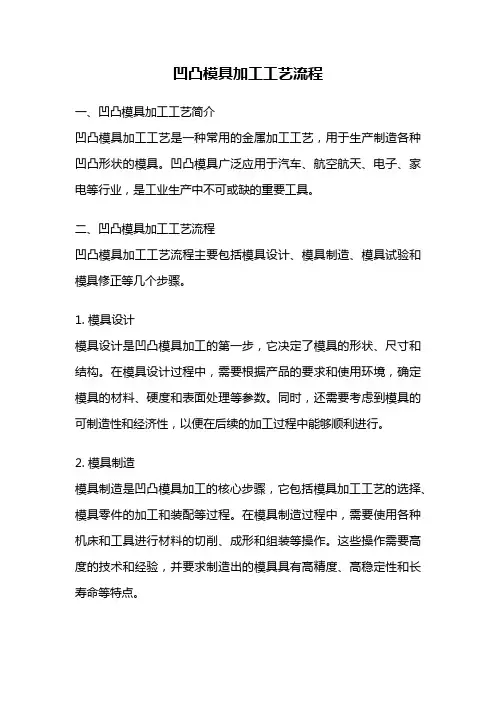
凹凸模具加工工艺流程一、凹凸模具加工工艺简介凹凸模具加工工艺是一种常用的金属加工工艺,用于生产制造各种凹凸形状的模具。
凹凸模具广泛应用于汽车、航空航天、电子、家电等行业,是工业生产中不可或缺的重要工具。
二、凹凸模具加工工艺流程凹凸模具加工工艺流程主要包括模具设计、模具制造、模具试验和模具修正等几个步骤。
1. 模具设计模具设计是凹凸模具加工的第一步,它决定了模具的形状、尺寸和结构。
在模具设计过程中,需要根据产品的要求和使用环境,确定模具的材料、硬度和表面处理等参数。
同时,还需要考虑到模具的可制造性和经济性,以便在后续的加工过程中能够顺利进行。
2. 模具制造模具制造是凹凸模具加工的核心步骤,它包括模具加工工艺的选择、模具零件的加工和装配等过程。
在模具制造过程中,需要使用各种机床和工具进行材料的切削、成形和组装等操作。
这些操作需要高度的技术和经验,并要求制造出的模具具有高精度、高稳定性和长寿命等特点。
3. 模具试验模具试验是凹凸模具加工的重要环节,它主要用于验证模具的性能和可靠性。
在模具试验过程中,需要根据产品的要求进行模具的调试和优化,以确保模具能够满足生产的需求。
同时,还需要进行模具的寿命测试和性能测试,以评估模具的使用寿命和生产效果。
4. 模具修正模具修正是凹凸模具加工的最后一步,它主要用于修正模具在使用过程中出现的问题。
在模具修正过程中,需要根据实际生产情况进行调整和改进,以提高模具的使用寿命和生产效率。
同时,还需要进行模具的维护和保养,以延长模具的使用寿命。
三、凹凸模具加工工艺的优势凹凸模具加工工艺具有以下几个优势:1. 精度高:凹凸模具加工可以实现高精度的模具制造,能够满足复杂产品的加工要求。
2. 稳定性好:凹凸模具加工制造的模具具有高稳定性和长寿命的特点,能够满足大批量生产的需求。
3. 生产效率高:凹凸模具加工可以实现自动化生产,提高生产效率和产品质量。
4. 经济性好:凹凸模具加工的成本相对较低,能够满足企业的经济需求。
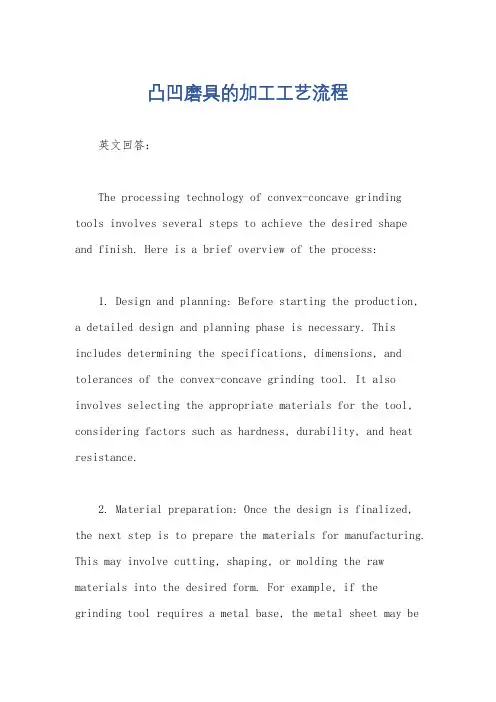
凸凹磨具的加工工艺流程英文回答:The processing technology of convex-concave grinding tools involves several steps to achieve the desired shape and finish. Here is a brief overview of the process:1. Design and planning: Before starting the production,a detailed design and planning phase is necessary. This includes determining the specifications, dimensions, and tolerances of the convex-concave grinding tool. It also involves selecting the appropriate materials for the tool, considering factors such as hardness, durability, and heat resistance.2. Material preparation: Once the design is finalized, the next step is to prepare the materials for manufacturing. This may involve cutting, shaping, or molding the raw materials into the desired form. For example, if thegrinding tool requires a metal base, the metal sheet may becut and bent into the required shape.3. Machining: Machining is a crucial step in the production of convex-concave grinding tools. It involves using various machining techniques such as milling, turning, drilling, and grinding to shape the tool. For example, milling machines may be used to remove excess material and create the desired contours, while grinding machines can be used to achieve the required surface finish.4. Heat treatment: Heat treatment is often employed to enhance the hardness and durability of the grinding tool. This process involves heating the tool to a specific temperature and then cooling it rapidly or slowly, depending on the desired properties. Heat treatment can improve the wear resistance and toughness of the tool, ensuring it can withstand the demanding grinding applications.5. Surface finishing: After the machining and heat treatment processes, the convex-concave grinding tool may undergo surface finishing to achieve the desired smoothnessand precision. This can be done through processes such as polishing, lapping, or electroplating. For example, polishing can help remove any surface imperfections and create a mirror-like finish on the tool.6. Quality control: Throughout the manufacturing process, quality control measures should be implemented to ensure the final product meets the required specifications. This may involve conducting inspections, measurements, and tests at various stages of production. For example, dimensional checks, hardness tests, and surface roughness measurements can be performed to verify the quality of the grinding tool.中文回答:凸凹磨具的加工工艺流程涉及多个步骤,以实现所需的形状和表面光洁度。